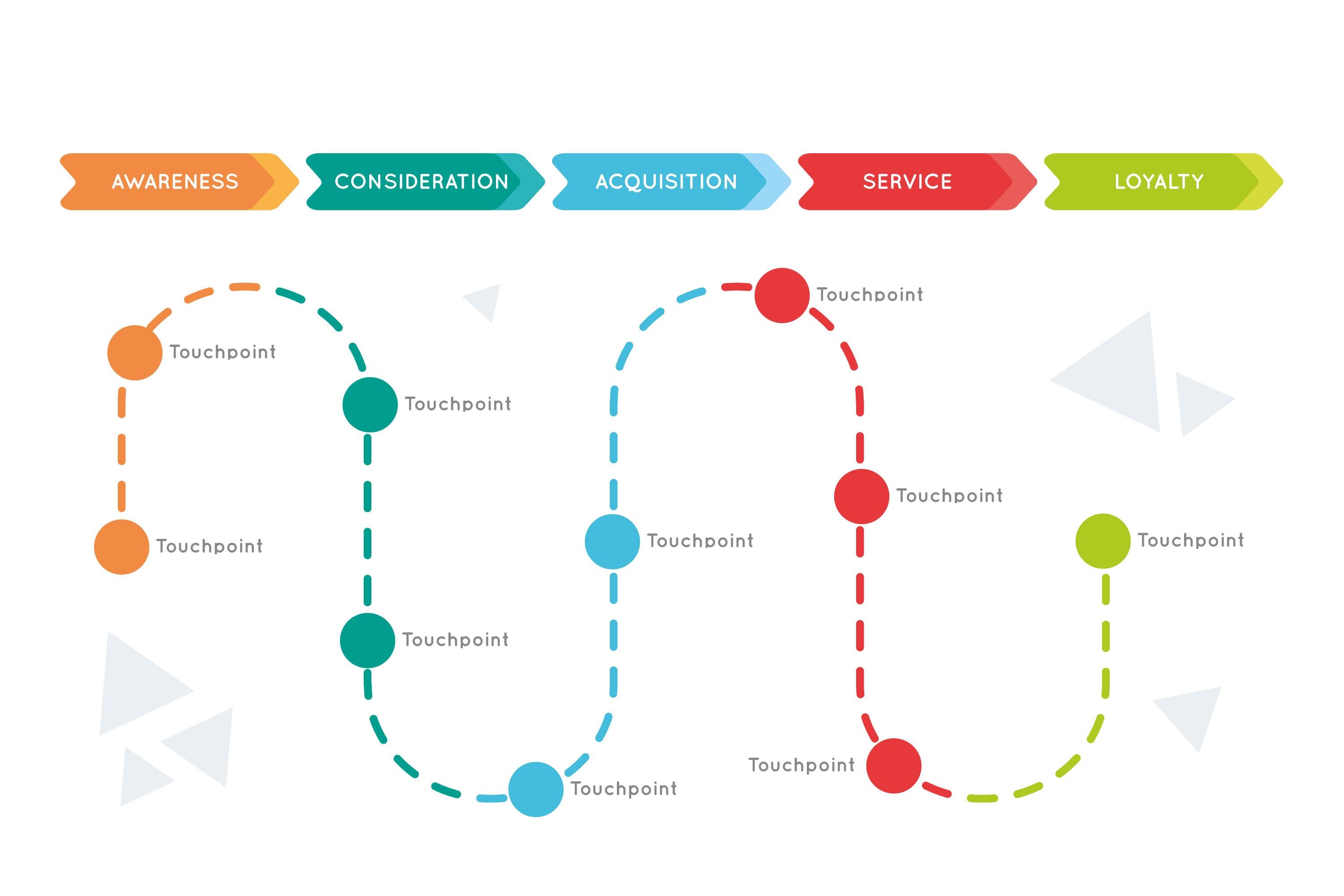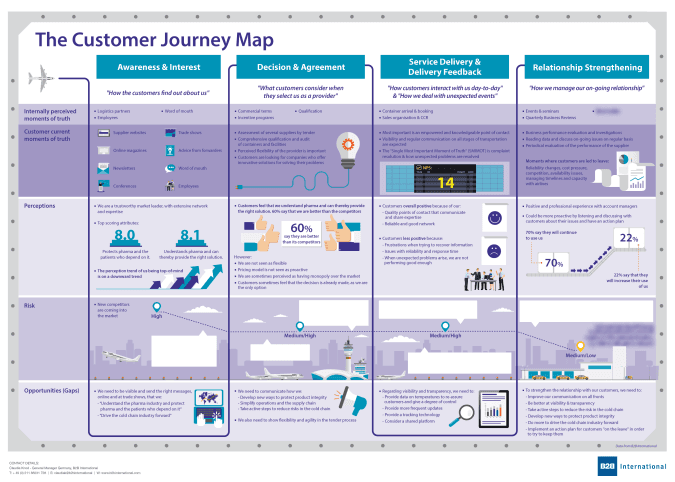Customer Journey Mapping for B2B
Buyers go through different phases and touchpoints before they buy from you. Especially for B2B businesses, where customer journeys are really long, the process can look like a maze. They will engage with several touchpoints before conversion. Knowing how customers engage with you is crucial to connect the dots and improve the buying experience of customers. According to Salesforce, over 80% of customers consider their experience with a company to be as important as the product itself.
What does a marketer need to do?
- Track how customers engage with each touchpoint.
- Let sales reps know a lead’s journey to help them close better.
- Create extensive reports of each brand touchpoint.
- Prioritize touchpoints that lead to conversions.
- Optimize low converting touchpoints.
- Identify causation of churn.
This is where customer journey mapping plays an important role in understanding your customers.

What is Customer Journey Mapping?
Customer journey mapping helps connect the dots between different steps a lead takes to transform into a customer. According to a study, 95% of companies felt that creating a customer journey map helped them increase customer satisfaction.
So, why do so many companies feel it is essential to do customer journey mapping? Let’s take an example.
You have a vast database of customers. They purchase your product and say they are happy with it. But your churn rate is slowly rising. Mapping your customer journey could throw light on any bad experience that might have skipped your radar and can help highlight the reason for customer churn.
On the surface, business-to-business (B2B) and business-to-customer (B2C) customer journeys look poles apart.
In reality, even in B2B, you are not just selling to companies, but real people behind the face of a company who have their own needs, wants, and biases, just like in B2C. In fact, in B2B, you have to convince at least 4-5 decision-makers in each organization for each sale, making the buying cycle longer than B2C. Right from gatekeepers, mid-level employees, senior-level employees, and C-suite. This makes the B2B customer journey elaborate and time-consuming.
According to a survey by B2B Buyer Behavior, 68% of buyers indicated that the length of their B2B purchase cycle has increased significantly compared to even a year ago.
A typical B2B customer journey in the SaaS industry looks like this:
- A prospect becomes aware of your brand: Prospect stumbles upon your product through an ad, social media, website, or word of mouth. Prospect looks up your service or product on your website and downloads an ebook to understand more about your product and how it can solve problems.
- Engagement: Prospect receives emails, more content, and demo from you, that explains the product further and makes them aware of benefits. Engagement will also happen in the later stages.
- Conversion: Prospect gets convinced that your product is a fit for them, signs up for your product, and is ready to use your product.
- Onboarding: Your product is finally ready to be used by the prospect. You set it up and let them have a go at it.
- Adoption: Product is implemented across the prospect’s organization with the help of your support team, and new users are educated.
- Renewal: Hopefully, your prospect likes your product and renews your subscription. If you are a SaaS company, it might also be going from free trial to subscription.
- Retention and Referral: Customers keep using your product. They are so delighted by your product that they recommend it to peers and others in the industry.
Benefits of successful customer journey mapping
1. Catch the pulse of your target audiences better
Sometimes drawing a mental map of your audience with who you have never interacted with before can be challenging. What if your assumptions go wrong, or you underestimate their requirements?
Drawing a customer journey map can help you understand many aspects of the prospect like:
Who are you selling to?
- In which stage do they discover your brand?
- What are they looking for?
- Which platforms do they use to engage with you?
- What content are they engaging with?
2. Understand how leads flow through the buying cycle
A customer journey map helps you step into your customer’s shoes and walk with them through their buying journey.
It helps you tell the story of your customer’s experience across different touchpoints like social media, email, website, and other platforms and how they became a customer.
Buying cycles vary from firm to firm, but universally, they consist of the following stages:
Awareness stage: Prospects have stumbled upon your product or service through email, advertisement, a sales call, or they have become aware that they need a solution like yours.
Evaluation stage: Prospects evaluate available options in the market that can best fulfill their needs and compare your products or services with others.
Purchase stage: Prospects are convinced that your product or service fulfills their needs the most and are sales-ready.
3. Make the customer journey predictable for sales and marketing
On a daily basis, there is a lot of uncertainty between sales and marketing teams. They are not aligned and tend to be at loggerheads with each other over data visibility, customers, and revenue attribution.
The customer journey mapping exercise is a visual representation of the customer’s journey of buying your products. With this information,
- Sales teams can get context on the prospect’s intent to buy
- Marketing teams can share the right content at different stages of the funnel to nurture prospects into customers.
If you want to know more about how Sales and Marketing can easily align, read our free ebook.
4. Create a customer-focused strategy
Many times sales heads, marketers, and even business owners are guilty of blindly creating a sales process that doesn’t resonate with the speed at which customers want to be onboarded.
So, the process of customer journey mapping flips the coin, puts the spotlight back where it truly belongs: the customer.
For example:
- Do customers have a personalized experience while onboarding?
- Do they get nurtured through different touchpoints with relevant content?
- Can they reach out to customer support easily?
- What is a customer’s satisfaction score after speaking to your agent?
Asking more questions like these internally and across different departments will help you put together a mental map of the customer’s experience across your organization. It will also help reveal how the customer feels in each stage and where your company can improve the experience.
It will also help you gauge what went right and repeat that consistently to gain similar customers.
So, hold the lens over what your customers experience, and plan ahead to make an error-free and lucid customer-focused strategy.
Setting up a customer journey map
So, now you have understood what a customer journey map can help you achieve and its benefits. But how do you get started with creating one for your customers?
Here’s how.
1. Define a goal and set up an objective
There are different reasons why you want to draw a customer journey map.
- Did you notice a recent spike in customer churn and want to identify the reason?
- Do you want to know how customers engage with each touchpoint?
- Do you want to know to find out how each touchpoint is contributing to conversions?
- Do you want to optimize touchpoints?
- Do you want to make the customer journey predictable?
- Is your Net Promoter Score low, and you want to see what customers go through for giving you that low score?
These are some goals you may have before setting out to understand your customer buying journey and put together the customer journey map.
2. Model each buyer persona
Segmentation can really help understand different sets of audiences. If you sell a B2B product like industrial pumps, then you may want to segment your audience based on different industries from which your customers use it. How a SaaS startup company uses your product might be completely different from how an Enterprise equipment manufacturing company uses your product.
Segmenting customers based on industry, revenue, company size, and use cases can give you a clearer idea of each cohort’s journey.
3. Define all the touchpoints
There are various ways in which a prospect will engage with your product or company, and this includes before, during, or even after they have signed up. Some of these ways include online and offline touchpoints like:
- Advertisements
- Marketing materials
- Phone calls
- Social Media
- Email Newsletters
- Retargeting campaigns
Define important touchpoints for your company that directly affects KPIs and customer experience. For example, a landing page that is part of your marketing campaign and is an important lead magnet for you is malfunctioning and shows an error for your customer when they fill out the pop-out form. This causes an unpleasant situation for your customer, which can escalate quickly and prevent them from purchasing from you further.
One way in which you can track customer touchpoints online is by using reports within Google analytics. Using this, you can track traffic that navigates through your website, any pages with high bounce rates, which is an indicator of a bad experience.
Tracking offline touchpoints can take longer and be tedious but can be done through surveys, monitoring customer service calls, reviewing feedback forms and questionnaires.
4. Define customer actions and what defines a customer moving to the next stage of the customer journey
The best way to define your customer actions is to actually get into the shoes of the customer and do the things they would while discovering your product. While you are at it, write down all actions that they would perform before, during, and after their interaction with your product.
It could be a simple query on Google for keywords related to your domain area or reading a trade magazine and stumbling upon your advertisement.
After that, they would visit your website and request a demo. Or would they call your team and ask for a demo? Your list of actions need not be accurate, but they at least led you to think like the customer. This will help you draw a better map of the customer and personalize the experience and all future communications with them.
You can even make this into team activity, and ask different members of different teams within your organization to work on this, so you can discuss, rationalize, compare and draw a final map.
While doing this activity, you will also spot tedious activities that your customers are expected to do, so you can work on reducing the number of steps and close more sales.
To sum up, customer experience is an important factor to be considered at every stage of the sales process or even product design.
Customers are your biggest assets, and if the customer journey is smooth, they will go the extra mile to spend more time with your product, pay a premium amount for your service, and even refer your product to their peers.
Sell more, understand your customers’ journey for free!
Sales and Marketing teams spend millions of dollars to bring visitors to your website. But do you track your customer’s journey? Do you know who buys and why?
Around 8% of your website traffic will sign up on your lead forms. What happens to the other 92% of your traffic? Can you identify your visiting accounts? Can you engage and retarget your qualified visitors even if they are not identified?



